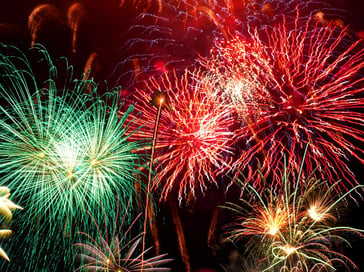 A favorite American tradition is to stare into the sky and watch fireworks explode overhead; Fourth of July just wouldn’t be the same without these brilliant displays. While watching these fireworks we don’t stop to think about what is actually making the explosion, but here at Hughes Environmental we deal with many of the firework ingredients on a daily basis.
A favorite American tradition is to stare into the sky and watch fireworks explode overhead; Fourth of July just wouldn’t be the same without these brilliant displays. While watching these fireworks we don’t stop to think about what is actually making the explosion, but here at Hughes Environmental we deal with many of the firework ingredients on a daily basis.
This is because the bright sparks and colors that make fireworks so inspiring to watch are made from a variety of chemicals and metals commonly used in manufacturing. When these metals are in a large chunk they are typically not flammable, and will only melt if exposed to high heat. When turned into a dust however, these combustible metals are capable of burning and even exploding.
A major issue comes from Aluminum dust that is created in manufacturing facilities and becomes airborne, only to explode. A block of Aluminum isn’t a fire hazard, but Aluminum dust is used in fireworks to produce silver and white flames and sparks.
Aluminum dust was the cause of fatal explosions in the Hayes Lemmerz manufacturing plant in Huntington, Indiana, an explosion in a Chinese factory making Apple products, and another Chinese plant that created aluminum wheels, which killed over 75 workers.
Iron dust and particles are used in fireworks to create bright sparks, and the heat the iron is able to reach determines what color it will be. Iron dust also was at fault for multiple explosions at the Hoeganaes facility in Tennessee, which claimed 5 lives and injured many more workers.
Titanium dust is actually classified as highly combustible, and comes with a specific set of handling instructions. When a firework creator wants to create bright silvery sparks in their display they use Titanium dust or flakes. In industry Titanium dust is most well-known for the explosion at the New Cumberland A.L. Solutions plant in West Virginia, which killed 3 workers.
Zinc is used in a variety of industries, and is used in fireworks to create smoke effects. It has also been used to create a smoke effect in other pyrotechnic applications, as well as the fuel for model rockets. To make it even more dangerous, Zinc dust is capable of spontaneously igniting if it comes in contact with water (Acetic acid is formed, which can create intense enough heat for combustion).
In the past, magnesium dust was used in flash bulbs for photography because of how bright the light from the burning dust could be. The heat from these flash bulbs caused many burns and fires, until other flash technology replaced it. Now, magnesium is mostly used in aircraft and automobile manufacturing due to its light weight and high strength. In fireworks Magnesium is used for the same reason it was used as a flash bulb, to create very bright white sparks and flashes.
In fireworks Copper dust is used to create blue and green colors. While the MSDS for Copper states that it isn’t combustible by itself, but when mixed with other flammable materials the dust can burn at extremely hot temperatures.

